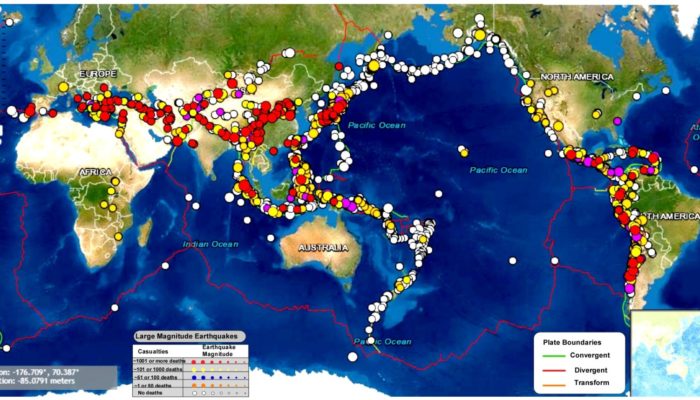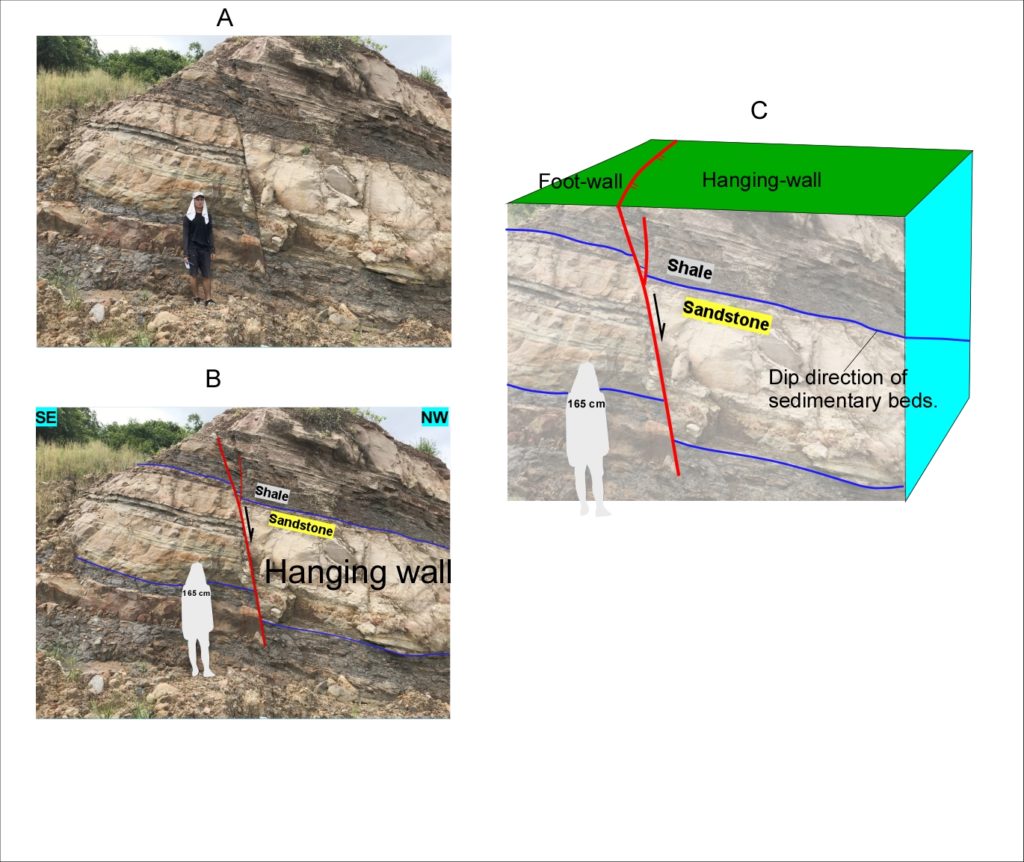
The earthquakes’ occurrence on the planet Earth is largely considered synonymous with disasters and people generally perceive geological faults as a threat to life and belongings. However, there are exceptions since a small community of earthquake researchers relate the occurrence of earthquakes with the lithospheric plate interactions where movement on faults causes earthquakes. Therefore, my motivation is to explore the world of faulting on Earth and convince you that faults are our friends.
Faults are pathways to release the stress that gets accumulated in rocks as strain, and when the strain overcomes the bearing capacity of a rock, it nucleates fractures, which later become faults. Therefore, faults are cracks that show some appreciable movement [1], and the major fault zones are located at the active lithospheric plate margins where most earthquakes occur [2]. Faulting usually signifies the brittle failure of Earth’s lithosphere, although there are examples of earthquakes that originate at more than 500 km, and the cause of deep earthquakes is much more complicated than a straightforward mechanism of brittle failure by frictional sliding or fracture that is observed at the shallow crustal levels of ~30km depth [3].
Faults cause earthquakes, and traditionally it has been perceived as their only task, hence these structures are usually considered synonymous with earthquake disasters. However, faults are much more than what meets the eye. The dynamic nature of our planet is largely dependent on the movement of the plates, which is facilitated by faulting. The heat engine that drives mantle convections at depth has to be translated into lateral and vertical movements of the lithosphere, which, being a bad conductor, preferentially breaks by fracturing and faulting [2]. Had it been a good conductor it would have radiated the mantle heat directly into the atmosphere, which would have caused warming of the planet. And such conditions would also lead to ductile deformation of the lithosphere without brittle faulting, which would hinder the smooth functioning of the plate tectonic cycle.
The three major types of plate boundaries that exist on the planet Earth [2] are usually associated with a large number of fault systems which is reflected by the occurrence of earthquakes that are dominantly concentrated at the plate interactions (Fig. 1). Faults are an important structural component of the lithosphere and record interactions with the underlying asthenospheric mantle and with the overlying hydrosphere, atmosphere, and biosphere. For example, the divergent or constructive plate boundaries are the regions where most of the Earth’s crust is created, and faults are integral to this process [4]. The normal faulting predominantly accommodates and compensates the process of crustal extension, which eventually initiates volcanism, and a large network of transform faults form to help the beginning of seafloor spreading, which occurs at a mature stage of a typical plate divergence process. Such tectonic settings are famous for volcanic massive sulphide deposits [5], which are major sources of copper (Cu) and zinc (Zn) that we use for various purposes.

Figure 2. Field evidence of a steeply NW dipping normal fault. The uninterpreted image is on top (A), and the interpreted normal faulting is sown below (B). The dip-slip displacement of lithological units (e.g. sandstone and shale) is consistent with a typical example of normal faulting where hanging-wall moves down relative to foot-wall (D). The photo was taken in Miri, Malaysia (modified after [15]).
Faults are also involved in the unearthing of the secrets of the deep earth by bringing up samples from crustal and mantle levels where human technological advancements would not suffice because the prevailing pressure and temperature conditions do not allow sampling at such depths. The global distribution of ophiolites, which are the remnants of old oceanic crust, is the best example to demonstrate the importance of crustal transport by faulting. Similarly, the scenic beauty of our planet is usually an outcome of mountain building processes observed at collision zones of the world, and faults form the backbone of these tectonic settings: examples include the Himalaya, the Andes and the Alps. These regions display some of the most amazingly looking fold and thrust belts with beautiful topographic expression, which is dominated by mountains and valleys, and it also hosts a variety of ore deposits (e.g. copper-molybdenum porphyry deposits) which further testifies the importance of faults for our economy [e.g. 7, 9].
Therefore, during the evolutionary journey of the Earth: from birth until today, faults have played a key role in maintaining the temperature at the surface, driving the dynamics of convection currents at depth, the formation of oceanic and continental crusts, and various mineral deposits that drive our economies. The land that we call home is a product of faulting, and have existed much before any trace of life thrived on the planet [11], that includes the young ~10 thousand years old human civilization. Faults have largely contributed in making life comfortable for us but this realization has not been part of our scientific wisdom and therefore it will be prolific to delve into this beautiful realm and explore the intricate relationship that exists between faulting, earthquakes and the existence of life on our ‘Blue Marble’. It will help us to transport our scientific knowledge to new horizons by involving in experiments, discoveries etc. to explore ideas and resources on how earthquakes and faults play an important, critical, and significant role in our survival, which may change our perspective on how to deal with faults.
Major earthquake disasters have indeed challenged us for centuries where it has caused unfortunate loss of millions of lives and damage worth billions. The devastations forced scientists to look for answers and therefore right from the birth of the seismological sciences until today significant progress has been made in scientific wisdom on earthquakes. This has led to technological advancement, which further helped us to understand the cause of earthquakes to make the living with earthquake hazards safer [e.g. 12] by the construction of earthquake-resistant buildings, smart urban planning, retrofitting and so on, but we have largely failed to predict earthquake events, which is an ongoing and complicated research problem [13, 14]. However, the major problem that I feel we could have solved to a large extent is about our progress concerning earthquake science education and outreach in the world, and particularly in countries with a poor sense of responsibility towards solving earthquake-related problems, and it includes both the developed and developing nations. The knowledge about the formation of faults should become a part of our curriculum, and we should spend more resources on educating people about the importance of faults in our existence, and how to live like good friends and not foes! There is a lot to uncover on why these structures exist under our feet, and our curiosity to link faults with our existence may help us unravel much more than what we have achieved thus far.
References
[1] Fossen, H. (2016). Structural geology. Cambridge University Press.
[2] Gubbins, David. Seismology and plate tectonics. Cambridge University Press, 1990.
[3] Billen, M. I. (2020). Deep slab seismicity limited by rate of deformation in the transition zone. Science Advances, 6(22), eaaz7692.
[4] Shah AA (2014) Large mantle magma reservoir of Afar, Ethiopia. Front. Earth Sci. 2:5. doi: 10.3389/feart.2014.00005
[5] Sawkins, F. J. (1972). Sulfide ore deposits in relation to plate tectonics. The Journal of Geology, 80(4), 377-397.
[6] Umar, B. A., Gholami, R., Nayak, P., Downey, W. S., & Shah, A. A. (2019). Normal fault geometrical trends and interactions in an onshore oilfield Niger Delta Basin, Nigeria. Journal of Petroleum Science and Engineering, 177, 579-593.
[7] Sillitoe, R. H. (1972). A plate tectonic model for the origin of porphyry copper deposits. Economic Geology, 67(2), 184-197.
[8] Weatherley, D. K., & Henley, R. W. (2013). Flash vaporization during earthquakes evidenced by gold deposits. Nature Geoscience, 6(4), 294-298.
[9] Sylvester, A. G. (1988). Strike-slip faults. Geological Society of America Bulletin, 100(11), 1666-1703.
[10] Richards, J. P. (2015). Tectonic, magmatic, and metallogenic evolution of the Tethyan orogen: From subduction to collision. Ore Geology Reviews, 70, 323-345.
[11] Navakanesh, B., Shah, A. A., & Prasanna, M. V. (2019). Earthquake education through the use of documentary movies. Frontiers in Earth Science, 7, 42.
[12] Bertero, R. D., & Bertero, V. V. (2002). Performance‐based seismic engineering: the need for a reliable conceptual comprehensive approach. Earthquake Engineering & Structural Dynamics, 31(3), 627-652.
[13] Hough, S. E. (2010). Predicting the Unpredictable: The Tumultuous Science of Earthquake Prediction. Princeton, NJ: Princeton University Press, 272. doi: 10.1515/9781400883547
[14] Satake, Kenji (2020). Earthquake Disasters and Government Committees. Human Geoscience, pp. 119-131. Springer, Singapore, 2020.
[15] Batmanathan, N. M., Shah, A. A., & Phmy, A. (2020, December). Miri Hill Structure Has Formed by Normal Faulting at the Releasing Bend Geometry of Strike-Slip Faulting. In 82nd EAGE Annual Conference & Exhibition (Vol. 2020, No. 1, pp. 1-5). European Association of Geoscientists & Engineers.
About the author
 Afroz Shah is an Assistant Professor of Structural Geology at the Department of Geosciences, Universiti of Brunei Darussalam (UBD). He has completed PhD at James Cook University, Australia in 2010, post-doctorate at Earth Observatory of Singapore in 2013 and joined the first academic job as a Senior Lecturer of Structural Geology at Curtin Sarawak, Miri, Malaysia before joining UBD. His research mainly involves brittle deformation of lithospheric plates with the main focus on earthquake-causing faults in South and Southeast Asia. He is enthusiastically involved in earthquake science education and outreach and writes frequently in newspapers, magazines, and now blogs!
Afroz Shah is an Assistant Professor of Structural Geology at the Department of Geosciences, Universiti of Brunei Darussalam (UBD). He has completed PhD at James Cook University, Australia in 2010, post-doctorate at Earth Observatory of Singapore in 2013 and joined the first academic job as a Senior Lecturer of Structural Geology at Curtin Sarawak, Miri, Malaysia before joining UBD. His research mainly involves brittle deformation of lithospheric plates with the main focus on earthquake-causing faults in South and Southeast Asia. He is enthusiastically involved in earthquake science education and outreach and writes frequently in newspapers, magazines, and now blogs!
Post edited by: Gabriele Amato, Giulia Roder and Asimina Voskaki

RAJ KIRAN DHIMAN
Very Interesting Article. This articles gives a very different perspective to look at faults. Best wishes to Author !!
Dr. Ahsan Ul Haq
This is amazing writeup.
Prasanna M. Gunawardana
This is very interesting article. However, I would like to suggest compare the reference 3 (Billen 2020) of the above article with the following paper which has proposed the same mechanism for the deep Earthquake formation in year 2017 for future research.
Gunawardana, P.M., Morra, G., Correlation between elastic energy density and deep earthquakes distribution, Journal of Geodynamics 106, pp. 33–45 (2017).
Shreya
Indeed an interesting article…a different take on how faults are our friends…I totally agree with the author on educating people and spreading awareness…
Magali Billen
I really enjoyed reading your article, which nicely discusses all the different roles that faults play on the planet.
Too often when we teach about faults we focus only on the damage they cause, and not on the benefits they bring. One could imagine a quarter-long class centered around faulting as a way to learn about so many different aspects of geology, geophysics and the beautiful landscape we live in.
Eena Arora
The article once again establishes the fact that the nature has its own mechanism. It is not a dependent entity that can only break or bend. It is very much independent and has a self sufficient making or breaking cycle. We humans only question or appreciate or react to what the eyes can see but we forget that the nature knows what it is doing. It has its own intelligence, elements and structures and what it only needs from us is the cooperation that we don’t hinder its functioning and risk the planet altogether.
Jon
Very interesting, informative, and well written article, thanks! My son was asking me about earthquakes and how they work, and this came up =)
Vale Cigala
Thank you, Jon, for the kind words!
I’m glad the post was useful.
Afroz Ahmad Shah
Dear all, thank you so much for your comments. It is a great pleasure to read your feedback. I am thrilled that the article has been useful to our readers.
Happy New Year.
Kind regards
Afroz
Mohammad Jaffar Mir
I would like to thank Dr Afroz for this amazing piece of writing.
Being a poor and impatient reader, every line of this writing amazed me to know about every Natural movement happening on this earth be it in the form of earthquakes, faults, volcanoes etc. I can say if the work will be presented in this way Dr. Afroz has presented, the curiosity of knowing the things among the students at early stage will rise to next level and this earth we call our home will have great researchers and scholars who will present the things in the same beautiful way that Dr Afroz has presented this wonderful piece of writing.